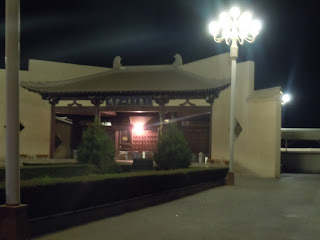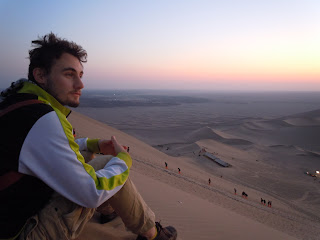Once in Dunhuang, we had the first afternoon free to explore the city and relax; Karen, Andras, and I ended up eating some Lanzhou hand-pulled beef noodles.
Sign literally translates to “Leisure Chain; Ant Cowboy Store; Dunhuang Branch”
*Note: “Ant” 螞蟻 are traditional characters, so I think this chain is from Hong Kong
*Note: “Ant” 螞蟻 are traditional characters, so I think this chain is from Hong Kong
We also had an interesting first evening. Andras, Karen, Cora, and I went walking again and stumbled upon a very large complex of restaurants in a single courtyard; we ended up eating very tasty Korean food; afterward we stumbled upon some sort of festivity. There were a good number of inflatables for little kids to play on and a large stage set up for performances. We stayed for four performances: a man singing, a troupe of girls dancing with ribbons on batons, some adults doing a “traditional” dance (we think that’s what the emcees said), though they were dressed similarly to flight attendants and their dance didn’t evoke any images I had of traditional Chinese dancing, and a group of girls doing a more Central Asian inspired dance (incorporated elements of belly dancing, especially in their costumes), although most of the girls looked Han Chinese and not Uyghur. Afterward the “talent show,” as we dubbed it because of the mediocrity of the performances, we stumbled back into the bazaar, which had transformed completely in the evening. Rows upon rows of stalls stood lit up and various street vendors had set up chairs and tables for customers to eat and drink and visit at. We ended coming back to this night market every night we were in Dunhuang.
The next day was probably our most jammed-pack day of the entire trip. Everybody had rather loudly voiced our opinion about how excited we were to ride camels in the desert, which meant we all got to wake up at 5:00am to make the trek to see in the sunrise in the desert. We arrived to the gate to the desert – that’s right, there’s a gate that you need to pay at in order to enter the desert that surrounds the entire city. Actually, the gate is merely the main entrance to the 鸣沙山 (Singing Sand Dunes) and the Crescent Lake Pagoda. We didn’t know that at the time of arrival, since everywhere was pitch-black.
The entrance to the desert at approximately 6:00am
We all were so impressed with the little bit of sand we could see in front of us because of the artificial lights, that we all scurried to take pictures in almost absolute darkness. I remember laughing to myself about this after leaving the desert a few hours later when everything is visible outside the gate once the sun had risen. Just inside the gate were two things that we would soon see a lot of: camels and orange protective sand boots. We all were excited about the camels, of course, but cared little to pay for boot covers to prevent getting sand in our shoes. It seems, however, that we were the only tour group who thought this way; except for us and maybe one or two other couples, every other single person we saw on the dunes wore these “desert fashion statements.” (See following pictures for evidence of orange boots.)
While on the camels, because we were in the desert outside a fairly small and not very developed city, the view of the stars in the night sky was amazing. I wish my camera were able to capture it, because I have never seen so many stars in my life. The Milky Way band was easily visible (I’m not sure if I’ve ever actually seen it in person before) and it seemed as if there was as much black space as white stars. However, the amazing view was slightly offset by the rather cold climate of the desert before sunrise. After riding the camels for maybe fifteen minutes, we dismounted and were allowed to climb up a sand dune to get a better view of the sunrise. However, climbing a sand dune in pitch black darkness is somewhat difficult; we made it eventually after one or two short breaks. Apparently there was a “ladder” to help make the ascent easier, thought it, too, cost some extra money; even if I had known about it before climbing the mountain the hard way, I don’t think I would have taken advantage of the shortcut. Plenty of tourists later did, though some were rather elderly and thus excusable. :P
Taken before sunrise, a sense of the scale of the desert and the dunes
Watching the sunrise was an interesting experience, as light was dispelling the darkness long before any of the actual sun was visible above the mountains in the distance. It didn’t immediately get scorching; surprisingly, I only started feeling hot as we were leaving around 10 am. The view atop the dunes was spectacular and my sense of perspective and scale were completely thrown off because of the massive scale of the dunes in a relatively barren landscape. One of our fellow students determined himself to climb up the sand dune over; after looking for him for a good ten minutes, we found that he had made the trek, but only after using the full zooming power of another student’s camera.
The sun peaking up over the mountains; the experience reminded me a lot of the opening of The Lion King movie
Looking away from the city (southward) during sunrise
We were given the option of sand sledding down the hill we had climbed earlier to get back to the camels. They were a lot of fun and although it bore many resemblances to sledding down a snow covered hill in the winter, the completely different setting made the whole thing seem surreal. After all successfully sledding down, we returned to our little camel troupes to head to the Crescent Lake Pagoda for a small breakfast.
The hill we first climbed and then sled down
A lot of people come to ride the camels, so naturally they all need to park somewhere
The Crescent Lake
Close-up of the pagoda tower
View of the pagoda and the Crescent Lake
After a brief return to the hotel and time for a shower and some quick rest, we headed out to Dunhuang’s main attraction: the Mogao Caves. This complex of around 500 caves carved into the face of the cliff houses the third largest Buddhist statue in China
View outside the cave that houses the third largest Buddha
Politics aside, the caves were as equally fascinating and as new an experience as the desert was earlier that day. Picture taking was restricted as the caves are all very dark and the flash would damage the paintings, but it’s almost incomprehensible that people for over 1,000 years had been carving small meditation rooms and painting them so elaborately. One particular cave depicted a Buddhist story about a Deer Goddess.
One day, a shepherd had fallen into a river and on the verge of drowning, was saved by the Nine-Colored Deer. As repayment for saving his life, the Nine-Colored Deer merely asked tha the shepherd not reveal the deer’s whereabouts, as many people wanted the nine-colored pelt. However, the local king later offered half of his kingdom to whoever could bring him to the Nine-Colored Deer because his wife desired its pelt. The shepherd was tempted by this offer, and told the king where the Nine-Colored Deer lived. The king then set off to hunt the deer, and upon trying to kill her, was stopped by her words. The Nine-Colored Deer told the king of how she had saved the life of one of his subjects; the king was so moved by the story that he refused to kill her. The Nine-Colored Deer then punished both the shepherd and the queen for their greed.
This Deer Goddess apparently has some strong connection with Dunhuang, because a good number of souvenirs had her depicted and an acrobatic play we attended was another story about the deer goddess and her daughter. The play was very interesting to watch, as it took a traditional story from the area (we think) and acted it out primarily through acrobatics. [Random note: in the middle of the play is when my first nosebleed of the trip happened. Luckily we had a lot of tissues with us, though I wonder what the Chinese man next to me thought…]
Dance in the forest with the Deer Goddess, apsaras, and woodland creatures
Full cast bow; girl in green and the girl in pink were the two main characters
*Note: just noticed there are two girls in pink; one must be an understudy/ double
*Note: just noticed there are two girls in pink; one must be an understudy/ double
The next day had an optional bike ride to Baima Pagoda. I, unfortunately, thought it best to skip the bike ride tour as I was still taking anti-inflammatory medicine for my prostrate and was specifically told not to ride bicycles by the Chinese doctor. Instead, I went with another student and we ate lunch together at a very small dumpling place and then went to an Internet café. While checking emails, my nose started bleeding again; it ended up bleeding for about 45 minutes to an hour, so it’s probably a good thing I didn’t go on the bike ride. Afterwards, we all boarded our next train to Lanzhou.












No comments:
Post a Comment